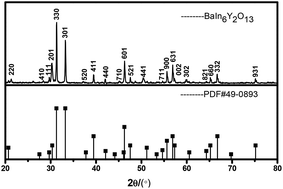White up-conversion luminescence power and efficiency in Yb3+-, Er3+- and Tm3+-doped BaIn6Y2O13†
Abstract
A series of BaIn6Y2O13:Yb3+, Er3+, Tm3+ phosphors with different dopant concentrations have been successfully synthesized by a sol–gel method. In order to obtain efficient white light emitting samples, tri-doped and biphasic samples were prepared. Afterwards, we carried out a systematic study on the up-conversion luminescence (UCL) properties of the samples as functions of doping concentrations and excitation densities. The up-conversion (UC) white light emission powers and efficiencies of samples with different dopant concentrations at different excitation power densities were obtained. The highest white UCL efficiency of up to 0.38% was achieved at excitation densities down to 17.5 W cm−2 in the biphasic samples. More importantly, we demonstrated that the UC materials with higher efficiency do not necessarily have stronger emission power, and the emission power is the most important parameter. A maximum emission power of up to 1.23 mW was obtained. Furthermore, the impact of temperature on the white UCL was studied, and transparent polymer composites that can emit white light were synthesized by doping BaIn6Y2O13 samples into polymethylmethacrylate (PMMA).


 Please wait while we load your content...
Please wait while we load your content...